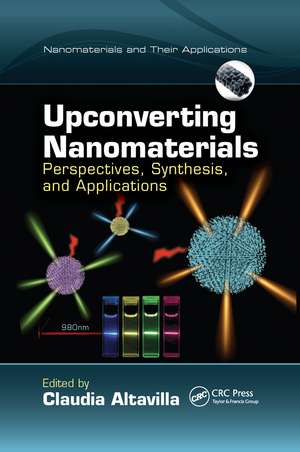Upconverting Nanomaterials: Perspectives, Synthesis, and Applications: Nanomaterials and their Applications
Editat de Claudia Altavillaen Limba Engleză Paperback – 30 sep 2020
Preț: 588.88 lei
Preț vechi: 692.80 lei
-15% Nou
Puncte Express: 883
Preț estimativ în valută:
112.70€ • 117.22$ • 93.04£
112.70€ • 117.22$ • 93.04£
Carte tipărită la comandă
Livrare economică 14-28 aprilie
Preluare comenzi: 021 569.72.76
Specificații
ISBN-13: 9780367655877
ISBN-10: 036765587X
Pagini: 393
Dimensiuni: 156 x 234 mm
Greutate: 0.55 kg
Ediția:1
Editura: CRC Press
Colecția CRC Press
Seria Nanomaterials and their Applications
ISBN-10: 036765587X
Pagini: 393
Dimensiuni: 156 x 234 mm
Greutate: 0.55 kg
Ediția:1
Editura: CRC Press
Colecția CRC Press
Seria Nanomaterials and their Applications
Public țintă
Academic and Professional Practice & DevelopmentCuprins
Section I: Synthesis and Mechanism. A perspective on lanthanide chemistry. Principle of luminescence upconversion and its enhancement in nanosystems. Synthesis of upconverting nanomaterials: Designing the composition and the nanostructure. Functionalization Aspects of Water Dispersible Upconversion Nanoparticles. Synergistic Effects in Organic-Coated Upconversion Nanoparticles. Tuning Optical Properties of Lanthanide Upconversion Nanoparticles. Upconversion Enhancement Using Epitaxial Core/Shell Nanostructures. Section II: Applications. Active-Core-Active-Shell Upconverting Nanoparticles: novel mechanisms, features and perspectives for bio-labeling. Upconversion Nanoparticles for Phototherapy. Upconverting Nanoparticles for Security Applications. Nanothermometry using Upconverting Nanoparticles.
Recenzii
"The editor has done an excellent job in both the selection of authors for the individual chapters and also in the way she has presented the chapters.
The authors have written this in a way that someone like me with little knowledge of the area can understand the principles but I believe that someone skilled in the area would also find this useful.
This book also provides a very broad reference platform as at the end of each chapter there are excellent, up to date references. You may have realised already, I think this book is well worth the £127 selling price."
—Peter Myers, Chromatographia Journal 2017
The authors have written this in a way that someone like me with little knowledge of the area can understand the principles but I believe that someone skilled in the area would also find this useful.
This book also provides a very broad reference platform as at the end of each chapter there are excellent, up to date references. You may have realised already, I think this book is well worth the £127 selling price."
—Peter Myers, Chromatographia Journal 2017
Notă biografică
Claudia Altavilla graduated in chemistry (cum laude) in 2001 and earned her PhD in chemistry in 2006 from the University of Catania, Italy. She worked as a visiting scientist at Ludwig Maximillians Universitat of Munich, Germany with Professor Wolfgang Parak and at the University of Florence, Italy with Professor Dante Gatteschi. From 2006 to 2013, she worked as a research fellow at the NANOMATES Centre of the University of Salerno, Italy. Currently, she is a research fellow at the CNR-IPCB (Institute for Polymers, Composites and Biomaterials), in Portici, Naples, Italy. Her research interests include: biopolymers, upconverting, magnetic, and 2D graphene-like materials for applications in materials science, civil engineering, lubricants, sensors, and biomedicine. She is a referee for international journals on materials science and nanotechnology. Dr. Altavilla is the author of several papers and monographs and holds two international patents. She is also the editor of Inorganic Nanoparticles: Synthesis Applications and Perspectives, CRC, November 2012.
Descriere
Over the past decade, high-quality, rare earth-doped upconversion nanoparticles have been successfully synthesized with the rapid development of nanotechnology. The synthesis methods are usually phase-based processes, such as thermal decomposition, hydrothermal reaction, and ionic liquids-based synthesis. At present, the low luminescence efficie






